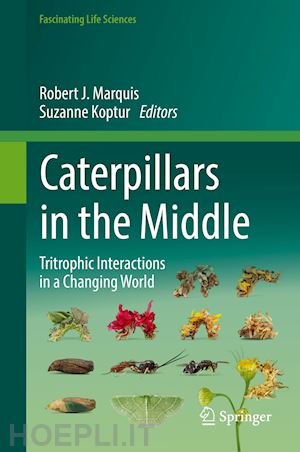
Questo prodotto usufruisce delle SPEDIZIONI GRATIS
selezionando l'opzione Corriere Veloce in fase di ordine.
Pagabile anche con Carta della cultura giovani e del merito, 18App Bonus Cultura e Carta del Docente
Chapter 11 is available open access under a Creative Commons Attribution 4.0 International License via link.springer.com.
The Natural History of Caterpillar-Ant Associations" is available open access under a Creative Commons Attribution 4.0 International License via link.springer.com.
1. David Wagner - Diversity of caterpillar adaptations in a complex evolutionary landscape.
Part 2: Impacts of the first trophic level, plants, on caterpillar ecology and evolution
2. Rupesh Kariyat – Surface warfare: Interactions between caterpillars and plant structural defenses.
3. Martha Weiss and John Lill – Role of host plants in mediating caterpillar-natural enemy interactions.
4. María-José Endara and Phyllis Coley – Reciprocal impacts of plant defenses and host choice by Lepidoptera in Neotropical rainforests.5. Richard Musser – Molecular ecology of caterpillar salivary defenses against host plants
7. May Berenbaum – Ecology and evolution of secondary compound detoxification systems in caterpillars
8. Paul Ode – Comparative caterpillar host plant interactions in agricultural and wildland systems: what can comparisons tell us?
9. Carmen Blubaugh and W.E. Snyder - Caterpillars drive patterns of growth and top-down suppression of competing phloem-feeders across diverse environments.10. Robert J. Marquis and Christina S. Baer – The tritrophic ecology of shelter-building Lepidoptera, and their impact on secondary inhabitants.
Part 3: Impacts of the third trophic level, natural enemies, on caterpillar ecology and evolution
11. John Stireman – Natural history and ecology of parasitoids attacking caterpillars.
12. Jayne Yack - Auditory adaptations in caterpillars.
13. Michael S. Singer, Riley M. Anderson, Robert E. Clark, Isaac H. Lichter-Marck, Kenneth D. Whitney, Kailen A. Mooney - Temperate forest caterpillars: how dietary specialization mediates their susceptibility to predators.14. Suzanne Koptur, Jaeson Clayborn, and Paulo Oliveira - Are cryptic caterpillars hidden from ants, other predators, and parasitoids?
15. Naomi Pierce – Caterpillar specializations for associating with ants.
16. Angela M. Smilanich, M. Deane Bowers, Nadya D. Muchoney, Heather L. Slinn, Lee A. Dyer - The gravity of top-down forces: effects of parasitoids and viruses on the ecology of caterpillars.
17. Hannah Rowland* – Background matching in caterpillars to escape bird predation.
Part 4: Multiple interactive effects among all three trophic levels
18. Laura Braga and Ivone Rezende Diniz – Caterpillar interactions in the
Cerrado seasonal environment and its importance in the face of climate change
19. Allen H. Hurlbert – Caterpillar phenology in space and time: exploring patterns from citizen science data.
Part 5: Caterpillar foodwebs in a world of rapidly changing climate
20. Karina Boege and Eck del-Val – Impacts of hurricanes on caterpillar foodwebs in a tropical dry forest of Mexico
21. Lee A. Dyer, Danielle M. Salcido, Matthew L. Forister, and Humberto Garcia Lopez – Variation in intensity of global change parameters determines declines and increases in plant-caterpillar-parasitoid interaction diversity.
Part 6: Synthesis
22. M. Deane Bowers – Caterpillars and chemicals: mediation of multitrophic interactions.
23. Suzanne Koptur and Robert Marquis – Synthesis and conclusions.Dr Suzanne Koptur is Professor Emerita of Biological Sciences in the Institute of Environment, International Center for Tropical Botany, Florida International University. Her research focuses on understanding plant/animal interactions with a focus on mutualisms, especially plant antiherbivore defense and pollination. She is also involved in cultivation of native wildflowers for creation of butterfly gardens, ecological schoolyards, and habitat restoration for rare species.
Dr Robert J Marquis is Professor Emeritus in the Department of Biology and the Whitney R. Harris World Ecology Center, University of Missouri–St. Louis. His research focuses on the interactions between host plant traits and the insects associated with plant, including natural enemies of caterpillars. Both temperate and tropical systems have been the focus of his research. He and his students and collaborators also study the impacts of forest management on caterpillar populations, all against a background of changing climate.











Il sito utilizza cookie ed altri strumenti di tracciamento che raccolgono informazioni dal dispositivo dell’utente. Oltre ai cookie tecnici ed analitici aggregati, strettamente necessari per il funzionamento di questo sito web, previo consenso dell’utente possono essere installati cookie di profilazione e marketing e cookie dei social media. Cliccando su “Accetto tutti i cookie” saranno attivate tutte le categorie di cookie. Per accettare solo deterninate categorie di cookie, cliccare invece su “Impostazioni cookie”. Chiudendo il banner o continuando a navigare saranno installati solo cookie tecnici. Per maggiori dettagli, consultare la Cookie Policy.